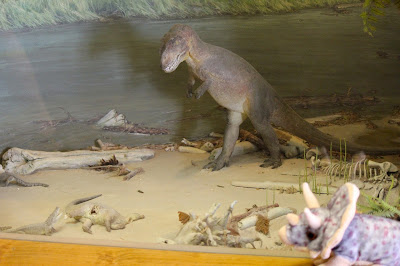Last Sunday, my girlfriend
Grace Albers and I drove down for a few nights to
Dinosaur National Monument in north western
Colorado and north eastern
Utah! We saw a TON of awesome things, and I am going to share it all with you over the course of numerous posts! First off, here are some pictures from our drive down there!
First off, we nabbed a few pics of my
cat,
Chimney, and
dog,
Daisy, before we left!
Pyg stops for a rest break at Lake Dillon near Frisco and Silverthorne!
Some pretty scenery on the road again!

A nice lunch of home made pasta salad, thank you
mother!
Around Rifle I believe, Grace spotted a
bald eagle! We were moving pretty fast (but not over the speed limit, of course), so we didn't get any good pictures, but it's still enough to tell that it's a bald eagle!
A bit after the bald eagle, we saw some
pronghorn, one of my most favorite animals of all time! We will be talking about the evolution of the pronghorns speed sometime within the next few weeks!
After the pronghorn stopped to look at us in the picture above, the pair took off, and we got some great action shots!
We kept driving, and got some more awesome shots of the surrounding landscape!
It wasn't too long before we saw our second group of pronghorn, this one much larger! Pyg tried to spot them, but you really need a zoomed in picture to see them. Actual eyes and a brain don't hurt, either.
Here are some closer pictures of the pronghorn! Below is a picture of a female.
Next, we have several shots of several pronghorn, with the male being the individual on the far right (or the only individual in the shot). While female pronghorn have
horns just like the males, they are much smaller, and are rarely pronged.
This looks like a female and a calf grazing!
Several shots of the sagebrush shrublands: Grace really enjoyed the landscape, as did I!
Finally, we were getting close to Dinosaur National Monument! We first reached the Canyon Visitor Center, which is situated right next to the beginning of the Harper's Corner scenic drive, which we will most definitely talk about later on! While we were at the visitor center, Pyg desperately wanted her picture taken next to this pre-
rennaisance, old school
Allosaurus model!
Utah, at last! More state signs need to have
dinosaurs on them, in my opinion.
Some more landscape shots!

We reached the small town of Jensen, and then turned north on the final leg of our journey! Right after the right turn however, we spotted some funky looking
deer, and went back a little ways to check it out! On someones private property was a group of several fallow deer, a species of deer that, although it has its origins in
Europe and
Asia, has been introduced on every continent except for
Antarctica! There were several small and cute
fawns in the mix, as well! Notice that all of the deer, regardless of age, are spotted. Unlike the mule and white-tailed deer fawns that live here in Colorado, the adults do not grow out of their white spots, and instead keep them their entire lives! We actually saw several of these critters at the drive through animal park near my
Gramma Roo's house in
Texas, click
HERE to check out that post, too!
At last, we reached the national park!
We stopped just inside the park to consult the map, and to check out the Green River! While our side of the river was National Park, the boundary of the park traced the rivers course for aways, as you can see in the picture of the map below. Right on the other side of the river was actually cultivated farmland, whose green pastures was a stark contrast to the arid sagebrush shrubland and desert right on the other side of the river. I wonder just how much water they use to keep all those plants green? We will actually talk more about water related issues in future posts of this series, including a fascinating fact that I learned about a dam! But that comes later....
There were several
Canada geese on one of the sandbars. It was weird for me to see them out here in the middle of nowhere: usually when I see them, they are pooping all over the green grasses of the schools near my house!
The scenery in the park is pretty spectacular, and here are just a few shots of some of the rocky outcrops that we saw right away!
We finally got to our campground, the Green River Campground (consult the map above), which, as you might have already guessed, is a campground right along the banks of the Green River. (If you didn't get that one, don't worry about it, it was supposed to be a tough one, most people don't get it the first time, either.) Here is a shot of some more gorgeous outcrops between the trunks of two cottonwood trees at our campsite, followed by a picture of our tent!
Immediately upon arrival, we were plagued by several golden mantled ground
squirrels who were positively itching for food scraps from us humans.
After we'd settled in, we decided to walk down to the river for a few minutes. It was really gorgeous there, and we saw a ton of what I think are
frog eggs in the water!
It was getting late in the day, but before the sun set, we wanted to go exploring. Grace is super into Archaeology (Grace:Archaeology::Zack:Paleontology), so we decided to go check out: some petroglyphs.
Join us for our next installment, coming shortly: In Which We Check Out Some Petroglyphs!
































































